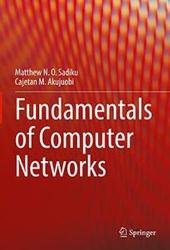Fundamentals of Computer Networks
- Добавил: literator
- Дата: 2-09-2022, 14:47
- Комментариев: 0
 Название: Fundamentals of Computer Networks
Название: Fundamentals of Computer NetworksАвтор: Matthew N.O. Sadiku, Cajetan M. Akujuobi
Издательство: Springer, Humana Press
Год: 2022
Страниц: 203
Язык: английский
Формат: pdf (true), epub
Размер: 53.5 MB
This textbook presents computer networks to electrical and computer engineering students in a manner that is clearer, more interesting, and easier to understand than other texts. All principles are presented in a lucid, logical, step-by-step manner. As much as possible, the authors avoid wordiness and giving too much detail that could hide concepts and impede overall understanding of the material. Ten review questions in the form of multiple-choice objective items are provided at the end of each chapter with answers. The review questions are intended to cover the little “tricks” which the examples and end-of-chapter problems may not cover. They serve as a self-test device and help students determine how well they have mastered the chapter.
The major objectives of this book are:
- To introduce students to how computer networks work
- To familiarize students with international standards for computer networks
- To bring to students’ awareness the newly emerging technologies in computer networking
Most books on computer networks are designed for a two-semester course sequence. Unfortunately, electrical and computer engineering has grown considerably, and its curriculum is so crowded that there is no room for a two-semester course on computer networks. This book is designed for a 3-hour semester course on computer networks. It is intended as a textbook for senior-level students in electrical and computer engineering. Their mathematical background should include calculus and probability. But no advanced mathematics is required.
The book is divided into 12 chapters, with each chapter self-contained.
• Chapter 1: “Introduction.” The introductory chapter defines computer networks and provides examples. It covers common protocols, types of computer network (LANs, MANs, and WANs), and popular applications of the computer networks.
• Chapter 2: “Digital Communications.” The idea of a digital communication system and all of the various components that make up the entire system are discussed in this chapter. This includes the transmission media, the encoding techniques, bit/byte stuffing, multiplexing, and the different types of switching techniques.
• Chapter 3: “Network Models.” In this chapter, the network models such as the Open Systems Interconnection (OSI) and the Transmission Control Protocol/Internet Protocol (TCP/IP) models are presented. This chapter also discusses the different networking applications—the internetworking system devices and Signaling Systems No. 7 (SS7).
• Chapter 4: “Local Area Networks.” This chapter covers the local area networks (LANs) and their different types. It mentions the advantages and disadvantages of the different topologies of LAN. All of the operational access methodologies including the controlled access devices are also discussed.
• Chapter 5: “The Internet.” This chapter introduces TCP/IP protocols and IP addresses. It discusses important issues facing the Internet: privacy, security, and safety. It also covers the next-generation Internet (IPv6) and Internet2, which is the future of Internet.
• Chapter 6: “Intranets and Extranets.” The excitement created by the Internet (a public network) has been transferred to modern networks called intranets and extranet. This chapter presents an introduction to intranets and extranets as two of the growing applications of Internet.
• Chapter 7: “Virtual Private Networks.” This chapter covers the main characteristics of virtual private networks (VPN), different types of VPNs, various applications of VPNs, and the benefits and challenges of VPNs.
• Chapter 8: “Digital Subscriber Line.” The chapter discusses digital subscriber line (DSL). DSL is a high-speed data technology which is also referred to as a broadband telecommunication system and constitutes part of the access technology network. The comparison between the different types of DSL is also made.
• Chapter 9: “Optical Networks.” This chapter gives an introduction to optical networks. It discusses some of the main optical components. It covers various optical networks: WDM-based networks, passive optical networks, SONET, all-optical networks, and free-space optics. It provides some applications of optical networks.
• Chapter 10: “Wireless Networks.” This chapter provides a brief overview of wireless communication networks. It considers wireless local area networks (WLANs), wireless metropolitan area networks (WMANs), wireless wide area network (WWAN), and wireless personal area network (WPAN). It explains cellular network, satellite networks, and wireless sensor network (WSN).
• Chapter 11: “Network Security.” In this chapter, the important aspects of network security are discussed. The chapter describes malware, firewall, encryption, digital signatures, intrusion detection and prevention, and cybersecurity and how they relate to network security.
• Chapter 12: “Emerging Technologies.” This chapter discusses some of the major emerging technologies including Internet of Things (IoT), big data, smart cities, blockchain technology, cloud computing, fog computing, edge computing, 5G networks, and cybersecurity issues. Steganography, an information security technique used in cybersecurity related issues, is also covered.
Appendix A covers old technologies such as X.25, Frame Relay, ISDN and BISDN, ATM, and MPLS, while Appendix B gives a short introduction to queuing theory.
Скачать Fundamentals of Computer Networks
[related-news] [/related-news]
Внимание
Уважаемый посетитель, Вы зашли на сайт как незарегистрированный пользователь.
Мы рекомендуем Вам зарегистрироваться либо войти на сайт под своим именем.
Уважаемый посетитель, Вы зашли на сайт как незарегистрированный пользователь.
Мы рекомендуем Вам зарегистрироваться либо войти на сайт под своим именем.
